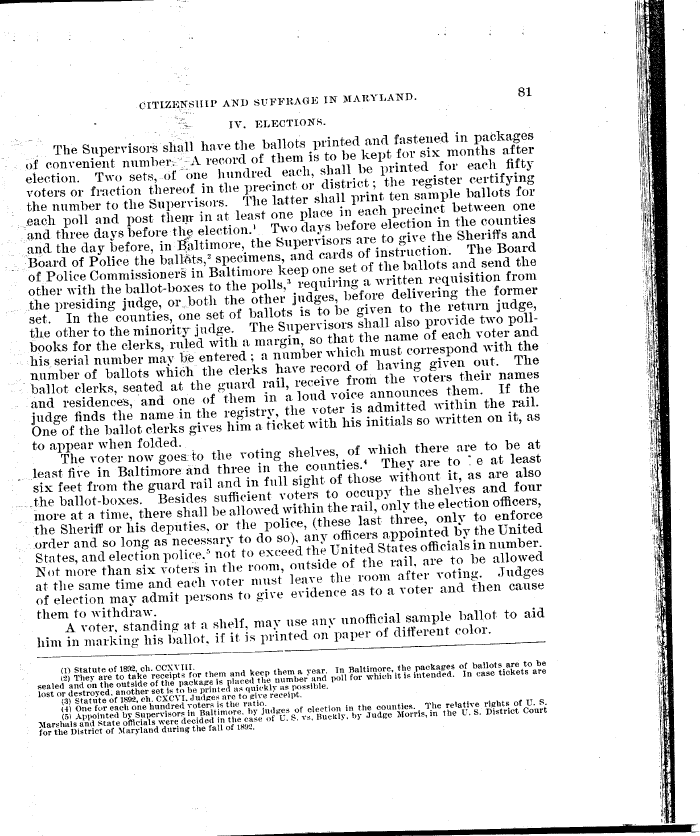|
81
CITIZENSHIP AND SUFFRAGE IN MARYLAND.
W'= It'. ELECTIONS.
The Supervisors shall have the ballots printed and fastened in packages
of convenient number: --A record of them is to be kept for six months
after ~~ ~~I,:
election. Two sets,-of --One hundred each, shall be printed for each
fifty ~'oIG
voters or fraction thereof in the precinct or district ; the register
certifying
the number to the Supervisors. The latter shall print ten sample ballots for
ouch poll and post theiri- in at least one place in each precinct between
one ~i'~i,'~
and three days before the election.' Two days before election in the
counties
and, the day before, in Baltimore-, the Supervisors are to (rive the
Sheriffs and Board _-Board of Police the bnll6ts,z specimens, and cards of
instruction-. The Board i!~i~l,
of Police Commissioners in Baltimore beep one set of the ballots and send
the
other with the ballot-boxes to the polls,' requiring a written requisition
from
the presiding judge, or both the other judges, before. delivering the former
011
set. In the counties, one set of ballots is to be given to the return judge,
the other to the minority, judge. The Supervisors shall also provide two
poll-
boobs for the clerks, I=tiled with a margin, so that the name of each voter
and
his serial number may be entered ; a number which must correspond with the
number of ballots u-hioh the clerks have record of having given out. The
ballot clerks, seated at the guard rail, receive from the voters their names
and residences, and one of them in a loud voice announces them. If the
judge finds the name in the registry, the voter is admitted within the rail.
One of the ballot clerks gives him a ticket with his initials so written on
it, as
to appear when folded.
The voter now goes
- to the voting shelves, of -which there are to be at
g ,;
least five in Baltimore end three in the counties.' They are to ~ e at least
. six feet from the guard rail and in full sight of those without it, as
are also
---the. ballot-boxes. Besides sufficient voters to occupy the shelves and
four
more at a time, there shall be allowed within the rail, only the election
officers,
the Sheriff or his deputies, or the police, (these last three, only to
enforce
order and so long as necessary to do so), any officers appointed by the
United
States, and election police,`' not to exceed the United States officials in
number.
Not more than six voters in the roam, outside of the rail, are to be allowed
at the same time and each voter must leave. the room after voting. Judges
of election ma.y admit persons to give evidence as to a voter and then cause
them to withdraw.
A voter, standing at a shelf, nlav use any unofficial sample ballot. to aid
hint in marhing his ballot, if it is printed on paper of different color.
(I) Statute of 1892, ch. CCSVIII.
12) They are to take receipts for them and keep them a tear. In Baltimore,
the packages of ballots are to be
sealed and on the outside of the package is laced the number and poll for
which it is intended. In case tickets are
lost or destroced, another set is to be printeF as quickly as possible.
(:3) Statute of 189-2, oh. CXCVI, Judges are to dive receipt.
t-t) One for each one hundred voters is the ratio.
(51 Appointed be Supervisors in Baltimore, by judges of election in the
counties. The relative rights of ti. S.
Marshals and State officials were decided in the case of ti. S. cs, Bucalc,
by- Judge Morris, in the i. S. District Court
for the District of Maryland daring the fall of 1892.
|

